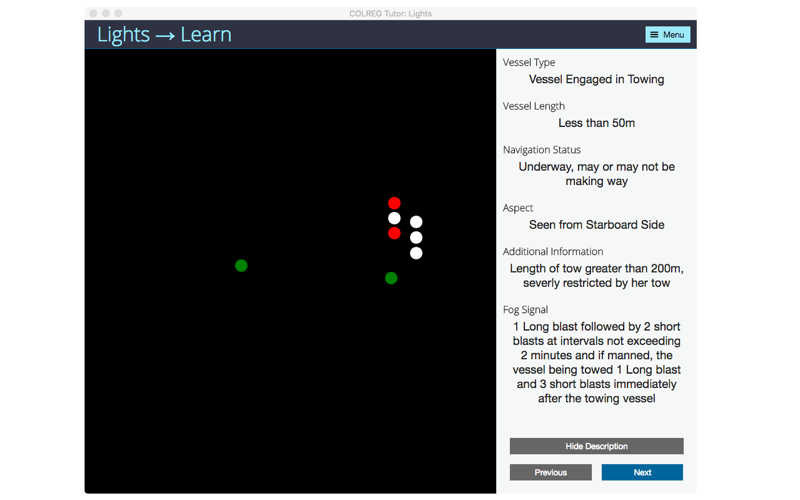
COLREG Tutor was created by Alistair Baillie, a merchant navy officer as a means of assisting cadets and deck officers studying for their MCA Orals Examinations to learn the practical side of the Collision Regulations.
Morse Code
The ability to send and receive Morse Code is a fundamental part of the Maritime and Coastguard Agency Signals Examination.
By using the learning feature you are able to go through the letters and numbers at your own pace, even adjusting the speed of the signal as you learn.
The Practice feature will test you on your Morse Code with three different modes, allowing you to either run continuously, stop after you identify every character correctly or stop after asking you each character once.
Nautical Flags
Hand in hand with the Morse Code is the requirement to identify the International Code of Signals Flags and know their single-letter meanings. As well as a handy printable help sheet detailing the flags and their respective meanings you can also use the learning feature to learn the flags and their meanings at your own pace.
The Practice feature will test you on your Flag knowledge, both with identifying the flag and optionally the meaning. With three different modes allowing you to either run continuously, stop after you identify every character correctly or stop after asking you each character once.
Lights & Shapes
The ability to identify vessels correctly from their Lights is a question that every candidate will be asked during their Maritime and Coastguard Agency Orals Examination. COLREG Tutor has a library of over 100 different configurations, including all that are commonly asked during the examination.
Use the learning feature to help you identify the vessels correctly at your own pace and when youre ready the practice feature allows you to test yourself in near exam conditions.
The program presents answers and expects answers from you in a similar format to what is commonly used by the MCA Examiners and UK Nautical Colleges.
Rule of the Road
Test your understanding of the practical application of the Collision Regulations. You will be presented with various common scenarios and asked to identify what action your vessel should take.
The format of the questions follows that which is commonly taught in UK Nautical Colleges and the answer format that is generally expected by the Maritime and Coastguard Agency.
After incorrectly or successfully answering each scenario the software will provide a detailed description of the reason your answer was considered incorrect or correct.
Buoyage
Learn to identify the various buoyage that is encountered under the IALA system (both region A and region B).
In practice mode, you will also be asked what action you should take upon encountering the buoy for various headings, in a similar manner to what can be expected during the MCA Orals Examination.


